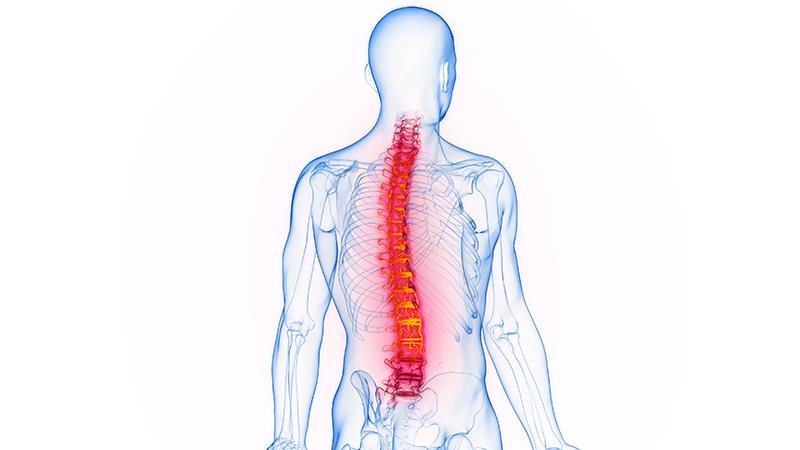Radiographic progression minimal even after long-term bimekizumab use in r-axSpA patients





Two years of treatment with the monoclonal IgG1 antibody bimekizumab led to minimal spinal radiographic progression in patients with radiographic axial spondyloarthritis (r-axSpA) in the open-label extension (OLE) of the phase III BE MOBILE 2 study.
By week 104, the mean absolute modified Stoke Ankylosing Spondylitis Spinal Score (mSASSS) was 7.6, which only yielded a 0.3 difference from the baseline mean mSASSS of 7.3, noted Dr Xenofon Baraliakos from the Ruhr-University Bochum, Rheumazentrum Ruhrgebiet Herne, Bochum, Germany, at EULAR 2024.
“One of the ultimate goals [of r-axSpA treatment] is to reach the lowest progression possible,” said Baraliakos. “The 0.3 [difference] is very close to zero, [thus indicating very little to] no progression.”
The mSASSS explained
To evaluate the radiographic changes in the spine using mSASSS, each vertebral corner of the cervical and lumbar spines (totalling 24 corners) is scored between 0 and 3. According to Baraliakos, these parts may only represent half of the spine, but these are areas with visible radiographic changes. “There is no overlay of the lung [like in] the thoracic spine area.”
A score of 0 or 1 would mean no abnormality or erosion/sclerosis/squaring, equating to subtle changes. A score of 2 or 3 would denote the presence of syndesmophytes or bridging syndesmophytes/ankylosis, which are indicative of clear radiographic damage or progression, Baraliakos explained.
In the subgroup of patients who did not have syndesmophytes at baseline (n=133), only 1.5 percent (n=2) developed new syndesmophytes after 2 years of bimekizumab treatment. [EULAR 2024, abstract LBA0003]
Among the high-risk group who did have syndesmophytes at baseline (n=57), 21 percent had new syndesmophytes by week 104. “Only one out of five did show progression over 2 years which, I think, is a very positive result,” he said.
Other outcomes
A majority of participants who received bimekizumab were non-progressors (ie, those who had no spinal radiographic progression). Based on the mSASSS change from baseline (CFB) ≤0.5 definition, the percentage of non-progressors was 85.3 percent. When looking at the mSASSS CFB <2 definition, the corresponding percentage was 92.1 percent, which included 83.1 percent of those who had existing structural damage (mSASSS ≥2) at baseline.
Among the evaluated potential predictive* factors in the univariate models, none were tied to a significantly increased likelihood of spinal radiographic progression (p>0.05 for all).
Dual IL inhibition
Preclinical evidence suggest that dual inhibition of interleukin (IL)-17A and IL-17F may have stronger inhibitory effects on new bone formation in axSpA compared with IL-17A inhibition alone. [RMD Open 2020;6:e001306]
Bimekizumab selectively inhibits IL-17F and IL-17A. Studies have reflected the sustained clinical efficacy of bimekizumab for up to 2 years across the full disease spectrum of axSpA, as well as long-term sustained efficacy in r-axSpA patients up to 5 years, noted Baraliakos.
“However, the impact of bimekizumab on structural progression in the spine, as assessed by radiography, has not been previously reported in r-axSpA patients,” he pointed out. “We also want to know how [bimekizumab fares] in terms of radiographic damage.”
As such, Baraliakos and team set out to assess the impact of bimekizumab treatment on 2-year radiographic progression in the spine of r-axSpA patients in BE MOBILE 2 (n=332). In the double-blind period of this phase III study, participants were randomized 2:1 to receive either SC bimekizumab 160 mg Q4W or placebo for 16 weeks. This was followed by a 36-week maintenance phase wherein all patients were on bimekizumab.
By week 52, 286 patients participated in the OLE, wherein bimekizumab was administered to all participants. Of these, 267 patients completed week 104 (72 percent men), while 190 had full datasets (ie, completed week 104 and had available mSASSS at both baseline and week 104) for mSASSS assessment.